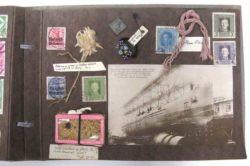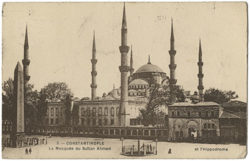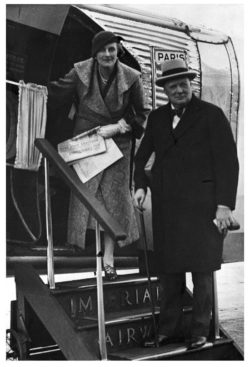Top Ten Collections: Women in International Life
Women’s role in international affairs can often be ‘hidden’ in narratives dominated by the careers of male politicians and diplomats. But records of women’s own international relations survive in many different ways in the archives, illuminating the way their work, social lives, and love affairs played out across borders and in global and imperial contexts. The Churchill Archives Centre holds the papers of diplomatic wives, women delegates to the League of Nations, Communist defectors, First World War ambulance drivers, and the first woman Professor of International Relations.
Part of a series exploring women’s personal papers in the Churchill Archives Centre’s collections, these lists are not exhaustive and provide a very subjective window onto some of our personal highlights.
10 Kathleen Wanstall (1886-1967)
Said to be a distant cousin of Winston Churchill, Kathleen Wanstall trained as a nanny in London during the 1900s. Between 1911 and 1919 she was employed by the Prince and Princess Wilhelm of Schloss Schönberg in Hesse, Germany, travelling with them to the Germany Embassy in Rome and then to Vienna during the First World War. She collected a scrapbook of documents and ephemera during her travels, including postcards, stamps, tickets, rings, and other small objects made by Russian prisoners of war.
The album and some objects from it, including a brisé fan, have been preserved in special conservation-grade boxes, and can be ordered in the reading room under the reference code MISC 98 .

Detail from Kathleen Wanstall’s travel documents, c. 1916 [MISC 98]

Page from Kathleen Wanstall’s scrapbook, containing ephemera and objects collected in Austria during the First World War, c. 1917 [MISC 98]
9 Svetlana Alliluyeva (1926-2011)
The youngest daughter of Josef Stalin, Alliluyeva was raised in the Soviet Union and worked as a lecturer and translator. In 1967, following the death of her husband Brajesh Singh, the Communist politician, she was allowed to return his ashes to his family. While in India she approached the American Ambassador and defected to the United States, marrying an architect, William Wesley Peters.
Highlights:
- ALIU 1/2: Papers relating to the planned addition to Alliluyeva’s memoirs, covering the period after her defection from the Soviet Union.
8 Minna O’Conor (1865-1933)
Lady Minna O’Conor, who featured in our top 10 list of women partners and secretaries, accompanied her husband Sir Nicholas O’Conor on diplomatic postings including to China, 1883-86 and 1892-95; Bulgaria, 1887-92; St. Petersburg, Russia, 1895-98; and Constantinople, Turkey, 1898-1908. Her personal papers contain letters, photographs, and newspaper cuttings collected during the course of their life abroad. Together with her husband’s diplomatic correspondence, they provide an alternative perspective on the lives of the diplomatic élite in the British Foreign Service during the late-nineteenth and early-twentieth centuries.
Highlights:
- OCON 13/1: Minna O’Conor’s private diaries and travel journals
- OCON 14/2-3: Press cuttings on the O’Conors’ lives and work in China and Turkey.

Postcard sent to Lady O’Conor for Christmas, from a member of the diplomatic service based in the British Embassy in Constantinople, 24 December 1912 [OCON 16/2/2].
7 Agnes Headlam-Morley (1902-1986)
Headlam-Morley became the first woman to hold a full professorship at Oxford, when she was appointed Montague Burton Professor of International Relations in 1948. She had been a tutor in modern history and fellow of St. Hugh’s College since 1932, specializing in Anglo-German relations, and was a founder member of the Anglo-German Association. Her first book was a comparative study of new constitutions in Europe following the First World War. She also edited a memoir written by her father, the diplomatic historian Sir James Headlam Morley, of the 1919 Paris Peace Conference.
Headlam-Morley’s papers include unpublished manuscript works on European history and correspondence, and are currently in the process of being re-catalogued.
6 Blanche, Lady Lloyd (1880-1969)
Blanche Lascelles (the older sister of Alan “Tommy” Lascelles, and a Maid of Honour to Queen Alexandra) married the Liberal politician and intelligence officer George Lloyd, later Lord Lloyd of Dolobran, in 1911. She accompanied her husband on his postings as Governor of Bombay, 1918-23, and High Commissioner in Egypt, 1925-29. Her diaries, along with her letters to her husband written during the First World War, survive in his papers.
Highlights:
- GLLD 28/1-15: Blanche Lloyd’s diaries, including accounts of her travels in Egypt (c.1903, and 1926-29), India, and Europe
- GLLD 4/2: Letters from George Lloyd to Blanche Lloyd from locations including Italy, France, and Berlin, where he had meetings with Hitler and prominent Nazis
- GLLD 4/28-30: Blanche Lloyd’s letters from India to her sister Helen, c. 1918-23

Detail from George and Blanche Lloyd’s British passport, issued in November 1918 [GLLD 1/12]
5 Cynthia, Lady Gladwyn (1898-1990)
Cynthia Jebb married the young diplomat Gladwyn Jebb in 1929. She accompanied her husband to Rome, where he had been posted in 1932 as a secretary in the British Embassy. In 1935 they returned to London, where over the next fifteen years Jebb’s diplomatic career kept him in the Foreign Office, before a key posting to New York City as the British representative on the UN Security Council. Cynthia’s talents as a society hostess were invaluable, especially in her husband’s final posting as British Ambassador to France (1954-60), where she ran the Embassy, managing the arrangements for several highly successful royal and prime ministerial visits to Paris at a crucial time in British relations with France. She kept a diary throughout much of the post-war era, giving her frank and vivid opinions of many of the social and political figures of the day, and published a book on the Paris Embassy in 1976.
Highlights:
- CGLA 2/2: Cynthia Gladwyn’s Paris diary, with an account of the Gladwyns’ visit to France following the Paris Peace Conference, including impressions of Ernest Bevin, Duff Cooper, and Lady Diana Cooper, January 1947
- CGLA 3/10: file of general correspondence and notes containing recipes and dieting tips collected by Cynthia while in charge of the British Embassy in France
4 Mary Agnes Hamilton (1882-1966)
As well as a socialist and feminist, Mary Agnes Hamilton was an ardent pacifist in her early career, and her third novel gained her critical attention for its portrayal of the dilemma faced by British pacifist intellectuals before and during the First World War. As a Labour MP from 1929 to 1931, one of her particular areas of interest was international relations. She was appointed one of two British women delegates to the League of Nations, where she worked on the Refugees Commission and the International Committee on Intellectual Cooperation. Her Second World War diaries, kept almost daily from 1938 to 1945, record her changing attitudes to war and European politics, and provide a fascinating document of her war work at the Ministry of Information and in the Reconstruction Secretariat, where she was mainly tasked with improving communications between Britain and the United States.
Highlights:
- HMTN 1/7: Diary containing an account of the Ministry of Information’s attempts to appeal to American interests in promoting the British war effort
- HMTN 2/4: Copy of Hamilton’s talk for the 1947 Montague Burton Lecture on International Relations, entitled ‘The Place of the United States of America in World Affairs’
3 Clementine Spencer-Churchill (1885-1977)
Clementine Churchill’s private correspondence with Winston reveals a more intimate side to a marriage often playing out across continents. Her papers also contain several files of letters and telegrams relating to her work in the Soviet Union as Chairman of the Red Cross Aid to Russia Fund in 1945. The collection also holds important visual materials, including a series of albums of Churchill family photographs with images from their global travels, and War Office photographs documenting the signing of the Atlantic Charter and the public face of other Second World War conferences.
Highlights:

Clementine and Winston Churchill posing on the steps of an Imperial Airways flight to Paris, c. 1934 [CSCT 5/4/99]
2 Mary Borden (1886-1968)
Mary Borden was born in Chicago in 1886 and graduated from Vassar College in 1907. On a tour of the Far East, she met and married her first husband, Scottish missionary George Douglas Turner. After becoming involved in suffragette politics in London after 1913, she served as a director of French field hospitals in both World Wars, for which she received military medals for bravery. Borden drew on her experiences of war for her poetry and several of her novels. Her papers are now kept with those of her second husband, Sir Edward Spears, whom she met on the Western Front in 1914.
Highlights:
- SPRS 11/2/1-6: Correspondence and notes on Mary Borden’s First World War work in France, including on the formation of her mobile hospital unit
- SPRS 11/3/1-3: Borden’s diaries kept during the Second World War, which she spent with the Hadfield-Spears Mobile Hospital Unit in France, Syria, and the Lebanon
1 Margaret Thatcher (1925-2013)
The UK’s first woman Prime Minister, the first politician since Churchill to achieve significant international standing, and still one of the most newsworthy individuals on the planet. The Thatcher Papers are vital to the study of international relations in the late-twentieth century, providing crucial source materials on the Falklands conflict, the end of the Cold War, and the Conservative Party’s relationship with Europe — produced by the hands of many of the people involved.
Highlights:
- THCR 1/20/3/1: Margaret Thatcher’s handwritten personal memoir of the Falklands conflict, compiled at Easter 1983.
- THCR 5/1/5/568-570: Papers relating to Thatcher’s ‘Bruges Speech’ to the College of Europe, Belgium, 20 September 1988

Photograph with dedication for Margaret Thatcher from US President Ronald Reagan: ‘As you can see, I agree with every word you are saying. I always do. Warmest friendship’, following a dinner at 10 Downing Street, 2 June 1988 [THCR 8/2/33]
